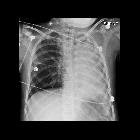Tubus im rechten Hauptbronchus













Endobronchial intubation is the not infrequent finding of the endotracheal tube located in a bronchus and is a trivial diagnosis to make in most instances provided an adequately penetrated chest radiograph is obtained. The incidence of endobronchial intubation is greatest following emergency intubation.
Clinical presentation
The main issue with intubation of a bronchus is the subsequent de-aeration of the contralateral lung and subsequent reduction in respiratory reserve. Since many patients who are intubated have respiratory compromise, this worsens their hypoxemia.
Longstanding physiological sequelae of endobronchial intubation include barotrauma secondary to ventilation of a solitary lung with higher pressures than normal. Hemothorax and pneumothorax may occur.
If endobronchial intubation is not reversed in a timely manner, cerebral hypoxia may result.
Radiographic features
Plain radiograph
Identification of the tip of the ETT and awareness of secondary signs of the endobronchial intubation is pivotal in making the diagnosis.
Ideally, ETT tip position should be below the interclavicular line and approximately 2 cm above the carina. This allows for tube tip movement when the neck is moved :when the chin is depressed, the tube tip will move downwards and when the chin is lifted, the tube tip will move upwards.
In circumstances where the carina cannot be visualized, its location can be inferred by identifying the azygos arch and the arch of the aorta.
The right main bronchus has a more vertical orientation than the left. Thus, if endobronchial intubation occurs, it is (more often than not) the right main bronchus that is intubated.
If the tube is inserted deep into the right main bronchus, the right upper lobe bronchus can be obstructed. This results in collapse of the left lung and the right upper lobe. (In some patients, an anomalous right upper lobe bronchus may be obstructed by a normally sited tube.)
Secondary signs of endobronchial intubation on chest radiograph include collapse of lobe/segments obstructed.
Ultrasound
Intubation of the right mainstem bronchus will result in the following findings as one sequentially insonates above the suprasternal notch and at both anterior lung fields ;
- suprasternal notch
- may demonstrate dilation of tracheal mucosal-air interface with posterior reverberation artifacts as the ETT cuff is inflated
- absence of the "double trachea sign"
- excludes esophageal intubation
- right anterior lung field
- presence of lung sliding
- left anterior lung field
- absence of lung sliding with a lung pulse present
- rhythmic oscillations of the pleural interface represent transmitted cardiac impulses
- implies contact of the visceral and parietal pleura, ruling out pneumothorax
- absence of lung sliding with a lung pulse present
Withdrawal of the endotracheal tube until lung sliding is reestablished bilaterally ensures correct placement prior to the confirmatory radiograph .
Differential diagnosis
In most instances, there is no differential, although other causes of lung collapse or hemithorax white-out should be considered. Most pertinent are:
- previous pneumonectomy
- lung collapse from other causes, e.g. mucous plug
Siehe auch:
und weiter:

 Assoziationen und Differentialdiagnosen zu Tubus im rechten Hauptbronchus:
Assoziationen und Differentialdiagnosen zu Tubus im rechten Hauptbronchus: